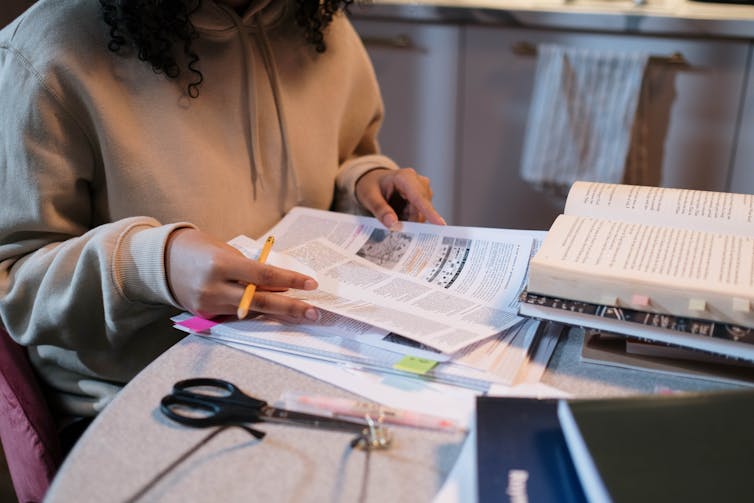
This article is part of our series on big ideas for the Universities Accord. The federal government is calling ideas to “reshape and reimagine higher education, and set it up for the next decade and beyond”. A review team is due to finish a draft report in June and a final report in December 2023.
Compulsory tests, essays, regular grades and timed exams are considered a given in university life. But the Universities Accord should change this.
Rigid, traditional assessments need to make way for a more flexible, personalised way of working out what students know and can do. The current system is not only vulnerable to cheating, it also disadvantages those with disability and doesn’t give students the feedback they need.
Read more: Introducing our new series on the future of Australian higher education
Students with disability need a different approach
Our research shows university students with a disability are disadvantaged by current assessment formats. It shows adjustments – which are legally required for those with disabilities – don’t always adequately compensate students.
For example, a common adjustment such as extra time for an essay or exam may not be suitable for students with a disability, whose outputs can be affected regardless of time.
Students in our research also reported that accessible spaces and equipment – such as an ergonomic chair – were not reliably available during exams. Even in online exams, text-to-speech software and other assistive technologies are not necessarily compatible with all course materials or assignment file formats.
Just over 7% of university students reported a disability when they enrolled in 2020. This is far less than 17.7% in the general population , which suggests there may be a hidden population of students with disabilities who could be better supported, or even that prospective students with a disability are discouraged from enrolling at all.
Research has shown students are hesitant to get an adjustment due to fear of stigmatisation, and experience anxiety or shame over requests for extra assistance to demonstrate their learning.

AI has radically changed the playing field
At the same time, the rise of generative artificial intelligence tools such as ChatGPT has shown universities need to rethink assessments so as to protect academic integrity.
We know ChatGPT can write material that is good enough to pass exams. So essays and take-home assignments that simply ask students to provide chunks of information will no longer work.
Assessments will need to evaluate more sophisticated capabilities, such as critical thinking, to prevent cheating and demonstrate students’ learning.
Read more: ChatGPT is the push higher education needs to rethink assessment
We also need to do better with feedback
Feedback is an incredibly important part of learning but current assessment approaches obscure helpful feedback to students.

To have the best impact on learning, feedback should not happen at the same time as students get their marks or final grade.
Instead, it should happen when students need it most: during the semester, so they can use it in subsequent tasks. Comments might be verbal, written or in multimedia formats, and come from lecturers, tutors, peers or even industry.
Many students fail a unit or exam at some point in their academic career. The coupling of assessment and feedback frequently means important messages are ignored or lost.
Survey research also shows about 15% of students are dissatisfied with the feedback they get, and this rises if students have a disability or are an international student.
How to improve assessment
There is a lot that could be done to improve assessment. But here are three significant changes we should focus on immediately:
1. We need to replace regular marks with regular feedback
Rather than final grades for every unit, students should receive regular comments about improving their work.
Then, at the end of their degree, selected assessments or a final project can be used to demonstrate a student’s learning.
Students might also be encouraged to portray their achievements in more contextual and personal ways. They might be able to choose between blog entries or multimedia. Or they might put together a “persuasive portfolio”, which enables students to construct their own evidence of how they are progressing towards course learning outcomes.
Targeting feedback to students’ specific goals is also highly motivating and leads to improved performance.
This will mean society - including employers - can be more confident that graduates have developed relevant high-level capabilities, rather than immediately forgetting the contents of an exam once it’s over.
This approach is also more inclusive. When individual tasks are considered separately, some formats might advantage particular students. But considering a range of tasks allows students to demonstrate their learning in a way that suits them.

2. Students should have choice in assessment
Assessment should promote individuality. It should provide choices for students to demonstrate their achievements, to ensure they meet their goals for their future lives.
For example, students studying public health might choose to develop a policy briefing or community education resources on a topic of their choice: both options can demonstrate understanding of a health issue and relevant communication techniques.
Impersonal, cookie-cutter assessments – such as a take-home exam or essay – are vulnerable to cheating. They also won’t teach students how to respond flexibly to evolving work environments.
Offering choice in assessment can also reduce anxiety and improve confidence in study as students are doing tasks that are more meaningful to them.
3. All assessment should be inclusive
All assessments need to be designed in ways to minimise additional challenges for students with disabilities or learning differences. Universal assessment design is one approach universities can use here.
This means ensuring instructions, resources, and submissions take multiple formats (for example, text and audiovisual).
We found even small changes, such as allowing students to take notes and read instructions out aloud in reading time, reduced anxiety for those with learning differences.
If implemented as a matter of routine, assessment for inclusion has the potential to improve the learning experience of many students from diverse backgrounds. Rather than just the ones who know about, and feel comfortable enough, to ask for help.
Read more: Why arts degrees and other generalist programs are the future of Australian higher education
The authors do not work for, consult, own shares in or receive funding from any company or organisation that would benefit from this article, and have disclosed no relevant affiliations beyond their academic appointment.
This article was originally published on The Conversation. Read the original article.







